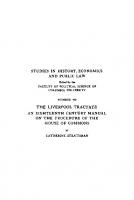The Travels of Ibn Al-Ṭayyib: The Forgotten Journey of an Eighteenth Century Traveller to the Ḥijāz 9780755610587, 9781848850064
In the eighteenth century, the academic scholar Ibn al-Tayyib made a rihla (journey) from Morocco to the Hijaz, in moder
237 68 5MB
English Pages [236] Year 2010
Recommend Papers

- Author / Uploaded
- El Mustapha Lahlali
- Salah Al-Dihan
- Wafa Abu Hatab
File loading please wait...
Citation preview
In memory of Ibn al-Tayyib al-Sharqi
ACKNOWLEDGEMENTS
We would like to express our gratitude to all those who have made this book possible. We wish to thank first and foremost our colleagues for their support and encouragement. We are deeply indebted to our families for their support and assistance throughout the writing stages of this book. Our special thanks go also to Joanna Godfrey and Randall Pederson for their assistance. Our sincere thanks also go to Dr. Emad Bazzi, Professor Dionysius Agius and Dr. Anne Macklin for their comments on the book. Our heartfelt appreciation also goes to all our friends for their support, help and encouragement.
INTRODUCTION
Travel literature among Moroccan travellers has a long and celebrated history, which has produced a list of prominent and eminent scholars such as Ibn Jubayr (died in 1217 AD/624 H), al-cAbdari (died in 1289 AD/688 H), Ibn Battuta (d. 1377 AD/ 779 H) and al-cAyyashi (d. 1679 AD/1090 H). Such scholars travelled for several reasons including pilgrimage, 'umrah, visit to the Prophet's grave, to seek knowledge and occasionally in an ambassadorial role. Furthermore they also left a wealth of literature, prose and poetry celebrating such journeys. In this regard one of the outstanding scholars of this field was Mul)ammad b. Mul)ammad al-Tayyib b. Mul)ammad b. Musa b. Mul)ammad al-Sharqi al-Sumayli, al-Fasi al-Madani, born in the city of Fez in 1698 AD/1110 Hand commonly named Ibn al-Tayyib. He studied with some of the most renowned scholars of Morocco at that time, in duding AbU al-cAbbas Al)mad al-Misnawi, Abu cAbdullah Mul)ammad al-Misnawi, Abu al-'Abbas Al)mad al-Fasi and Abu Tahir Mul)ammad al-Kurani. Having acquired his early education in his home country he emigrated eastward to Tunisia, Libya, Egypt and finally to Medina where he died in 1756/ 1170 after living and teaching there for many years. He was admired by many of the scholars he met, students who learnt from him and academics who came after him. In this regard al-Katani, the author of Fahras al-Fahiiris said about him, "During his time there were few men like him with respect to the extent of his wide knowledge in various disciplines and the strength of his intellect:' 1 It is not surprising, then, that this great scholar left behind him a treasure of works in a variety of fields of learning; indeed we find that Ibn al-Tayyib wrote many books, including four in jurisprudence, three in l)adith and sixteen in grammar and in linguistics. Despite this, however,
2
THE TRAVELS OF IBN AL-TAYYIB
many of his academic contributions remain in manuscript form and therefore are inaccessible to the great majority. One such work is Ril;la ila al-Ifijaz, which is particularly important to the field of travel literature as it represents a major contribution. This is because Ibn al-Tayyib came relatively late, historically, compared to other travel writers. Moreover, it contains many minute details, which the author took care to record during his journey from place to place. It also contains accounts of everything he saw and his comments regarding the social, economic and political conditions of the countries he visited, as well as comments about the scholars he met. This work is important also because it is considered the most important reference for the author's life and culture, and is an important literary reference in terms of the poetry and prose, both classical and modern, Eastern and Western, that it contains. It is the most important reference that provides information on this scholar during the period that he spent outside of North Africa. In addition, it gives accounts of both literary and religious scholars of the period. The manuscript describes the most important I:Iajj routes taken by Moroccans making I:Iajj during the eighteenth century, from Fez to the holy lands in the l:Iijaz. Like other travel writers of the period, the author discusses in detail the virtues and merits of travel. Bearing in mind the great significance of this work from all these aspects, this book provides a translation of the manuscript and a commentary on it. This book answers the pressing need to make available to the new generation books written by prominent scholars from past centuries. These manuscripts were handwritten, using very basic materials and techniques and, unfortunately, they have deteriorated due to neglect in the conditions of preservation throughout the ages, and because they were subject to various forms of damage, such as rot and poor storage. This book is an important contribution to the field of travel literature, as it provides an opportunity for those involved with and specialising in travel literature and Arabic literature, to benefit from it and pursue further studies on it. Significance of the Manuscript Manuscripts form a very important part of the heritage that was introduced by Arab and Islamic civilisation in many fields of knowledge as they provide historic sources. Manuscripts related to Arab and Islamic civilisation have remained neglected and forgotten and only a very few have been translated, authenticated and published in book form. Orien-
INTRODUCTION
3
talists in Europe and America have contributed to a large extent to the publication of these manuscripts but the list of unpublished Arabic manuscripts remains extensive. Ibn Tayyib's Manuscript
The original of the Ribla (trip) manuscript is to be found in a vault at Leipzig University Library in Germany under No: 476, Index: K.Voller. It contains 134 pages. The font is Naskh, in black ink. It is clear and moderate, neither fine nor thick. The size of the manuscript is medium relatively to others of the kind. The measurements of its plates are approximately 19cm long and lOcm wide. Each plate contains 27 lines with each line containing approximately 11 words. In the first plate of the manuscript, there is a frame written in faint gold ink, and six lines surround the text. However, this manuscript is seriously damaged in places - there are cuts in plate 129 (back), and plate (133 face). The following text was found on the first plate: all the different owners of the manuscript are mentioned on the first plate in a rather messy way. Here follows the text: This is the "Ribla" of al-Sayyid Abu



![The Travels of Ibn Jubayr: A Medieval Journey from Cordoba to Jerusalem [2019 (new introd.) ed.]
9781788318228, 9781786736659, 9781786726599](https://ebin.pub/img/200x200/the-travels-of-ibn-jubayr-a-medieval-journey-from-cordoba-to-jerusalem-2019-new-introdnbsped-9781788318228-9781786736659-9781786726599.jpg)



![The Diary of Elizabeth Drinker: The Life Cycle of an Eighteenth-Century Woman [Abridged Edition]
9780812206821](https://ebin.pub/img/200x200/the-diary-of-elizabeth-drinker-the-life-cycle-of-an-eighteenth-century-woman-abridged-edition-9780812206821.jpg)

